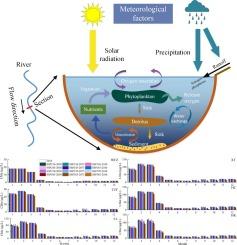应用耦合模型框架评估全球气候变化对中国汉江中下游河流型有害藻华的影响
IF 7
2区 环境科学与生态学
Q1 ENVIRONMENTAL SCIENCES
引用次数: 0
摘要
以变暖为特征的全球气候变化(GCC)会影响流域尺度上的水文条件,也会影响河流生态系统尺度上是否会出现有害藻华(HABs)。有关有害藻华的研究主要集中在海洋和湖泊,而 GCC 对河流型有害藻华的影响研究还较少,因为河流型有害藻华在水动力、水温和营养条件等方面与海洋和湖泊不同。本研究构建了包括 GCC 模型、降尺模型、水文模型、水动力模型和富营养化模型在内的耦合模型框架,分析和探讨了 GCC 引起的水生态环境变化对汉江中下游(MLHR)河道型 HABs 的影响。首先,基于三个 GCC 模型和 CMIP6 中的统计降尺度模型,获得了未来降水和温度等高精度气象因子。其次,基于 SWAT 和 MIKE21-ECOLab 的耦合模型与 MLHR 流域的数字高程模型(DEM)、土地利用、土壤、气象、污染源和实测地形数据相结合,并通过观测数据进行验证。第三,Chl-a 没有显著增加,GCC 的影响没有从根本上改变 HABs 的时空分布。第四,本研究提出以 0.2 m/s(对应排水量 1160 m3/s)作为防治沙洋段 HAB 的水动力条件。本文章由计算机程序翻译,如有差异,请以英文原文为准。

Applying a coupled model framework to assess global climate change impacts on the river-type harmful algal blooms in the middle and lower reaches of the Hanjiang River, China
Global climate change (GCC), characterized by warming, affects the hydrological conditions at the basin scale and whether harmful algal blooms (HABs) occur at the scale of river ecological systems. Research on HABs mainly focuses on oceans and lakes, and there is still less research on the effects of GCC on river-type HABs that differ from oceans and lakes in hydrodynamic, water temperature, and nutrient conditions. This study constructed a coupled model framework that includes the GCC model, downscaling model, hydrological model, hydrodynamic model, and eutrophication model, analyzing and exploring the effect of changes in the aquatic ecological environment caused by GCC on river-type HABs in the middle and lower reaches of the Hanjiang River (MLHR). Firstly, based on the three GCC models and statistical downscaling model in CMIP6, high-precision meteorological factors such as future precipitation and temperature were obtained. Secondly, a coupled model based on SWAT and MIKE21-ECOLab was used with the digital elevation model (DEM), land use, soil, meteorological, pollution source, and measured terrain data in the MLHR Basin, which was validated by observed data. Thirdly, there has not been a significant increase in Chl-a, and the impact of GCC has not fundamentally changed the temporal and spatial distribution of HABs. Fourthly, this study proposed to use 0.2 m/s (Corresponding discharge 1160 m3/s) as the hydrodynamic condition for preventing and controlling HABs in the Shayang section.
求助全文
通过发布文献求助,成功后即可免费获取论文全文。
去求助
来源期刊

Ecological Indicators
环境科学-环境科学
CiteScore
11.80
自引率
8.70%
发文量
1163
审稿时长
78 days
期刊介绍:
The ultimate aim of Ecological Indicators is to integrate the monitoring and assessment of ecological and environmental indicators with management practices. The journal provides a forum for the discussion of the applied scientific development and review of traditional indicator approaches as well as for theoretical, modelling and quantitative applications such as index development. Research into the following areas will be published.
• All aspects of ecological and environmental indicators and indices.
• New indicators, and new approaches and methods for indicator development, testing and use.
• Development and modelling of indices, e.g. application of indicator suites across multiple scales and resources.
• Analysis and research of resource, system- and scale-specific indicators.
• Methods for integration of social and other valuation metrics for the production of scientifically rigorous and politically-relevant assessments using indicator-based monitoring and assessment programs.
• How research indicators can be transformed into direct application for management purposes.
• Broader assessment objectives and methods, e.g. biodiversity, biological integrity, and sustainability, through the use of indicators.
• Resource-specific indicators such as landscape, agroecosystems, forests, wetlands, etc.
 求助内容:
求助内容: 应助结果提醒方式:
应助结果提醒方式:


